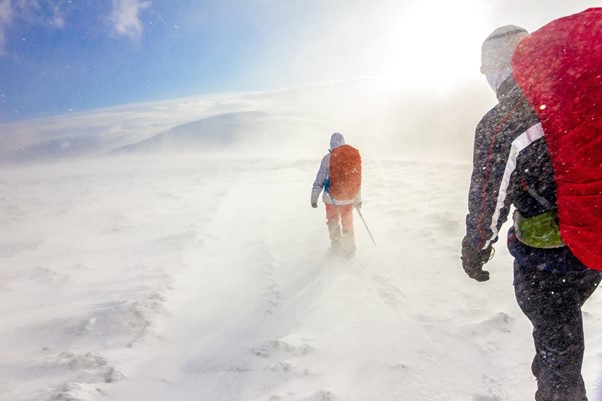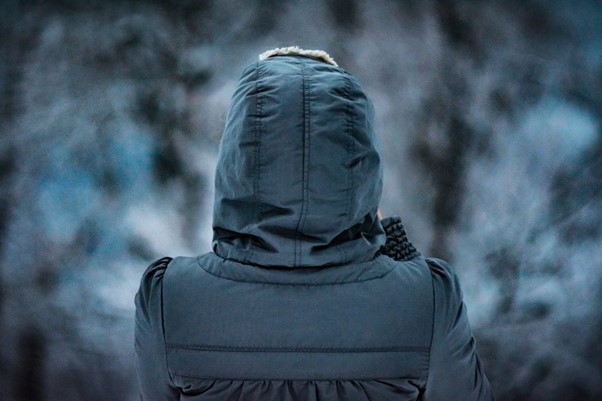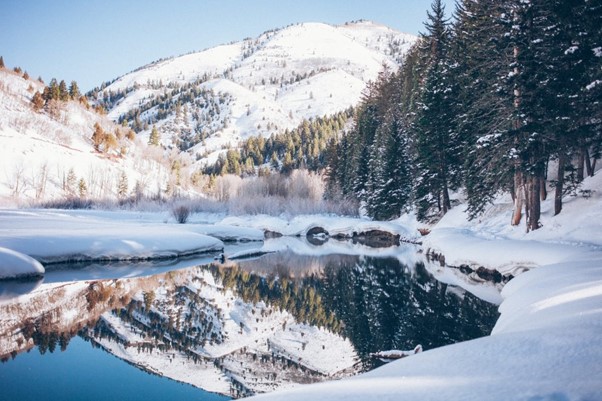written by Sophia Perry
Hiking in the winter is not for everyone – it can get cold, wet, and very slippery. But between the snow-covered treetops, frozen lakes, and the glittering sun, the views are stunning. So start looking up the best winter trails in the area now because you don’t want to miss out on spending this beautiful season in nature. However, before you put on your hiking boots and jacket, remember that hiking in the winter is most definitely not the same as hiking in the summer. Even for experienced hikers, it can be risky. That’s why you need to learn how to ensure safety during a winter hike, or your pleasant day outside can quickly turn sour.
The importance of ensuring safety during a winter hike
Every time you go on a hike, you take a risk. Typically, this risk isn’t major – you might fall and get scraped up, you’ll probably get a few insect bites, and on rare occasions, you might twist an ankle at worst. But winter weather brings different dangers.

Hiking in the winter is very different from hiking in the summer.
Cold is the obvious one. Prolonged exposure to low temperatures can affect you physically, making it harder to breathe, move, and even think clearly. This is why a wild camping adventure should be relegated to another season – spending a few nights outside in the winter is only for the most dedicated among us. Decreased visibility and difficulties with navigation are other things you need to prepare for. Even on a clear day without snowfall, it can be hard to find tracks when they are covered in snow. This can easily lead to getting lost in the wilderness. So how do you enjoy your favorite hobby and avoid these dangers at the same time?
Tips for increasing safety during a winter hike
It is perfectly possible to minimize risks and enjoy one of Ireland’s best winter hikes safely if you know how to prepare. So follow these tips:
Get an early start
You don’t get a lot of daylight in the winter, so use it wisely. Look up must-see destinations near you, so you don’t have to travel far, pack the night before, and start your hike early in the morning. No matter how weak, the sun will make it warmer while it’s out. The visibility will be better too. So don’t wait until later – when it comes to winter hiking, the early bird gets the worm every time.
Keep it short and sweet
The longer you stay outside, the more exposure you’ll experience and the higher the risk of something going wrong. So during the winter months, plan shorter hikes. How short exactly depends on your skill level. For some experienced hikers, a whole day in the mountain is not a problem, even during the colder months. But if you’re going with a less fit or less experienced group, and particularly if the group involves children, you’ll want to contain yourself to a couple of hours of outdoor activities at most. For example, kids love to do things outside, so you may want to make hiking a family affair. That’s a great idea as long as you keep in mind that children can’t regulate body temperature as well as adults. So you’ll need to stick to shorter trails during the winter as a safety precaution.

Don’t spend too much time outside when it’s cold; short hikes are safer and can be just as satisfying.
Don’t go alone
Hiking alone means not having anyone to rely on in case something does go wrong. During the winter, this can be an especially serious problem. Even a minor issue will turn into a crisis if you end up stranded on the trail without the possibility to contact anyone as the temperatures steadily drop. So it’s best to hike with others, especially if they have more experience than you. Not only will you be safer, but you’ll also have more fun!
If you insist on going alone, alert someone of your plans. Better yet, set up a check-in system where you contact them every so often to confirm everything is okay. If they don’t hear from you in a while, they can call for help in your stead.
Stay hydrated and eat well
Poor hydration and nutrition will only make your hike physically more demanding and more dangerous. So make sure to take sips of water whenever you stop and bring some nutritional snacks to eat when you get hungry. Warm drinks like tea and coffee are not a bad idea either; just remember that they are not a replacement for regular water. A water bottle is still one of the most important things to have during a hike, regardless of the season.
Dress for the occasion
One of the best ways to protect yourself from hypothermia is to wear the right shoes and clothes. You’ll want to dress in layers so you can maintain body heat and adjust your clothing in case the weather changes. Your outer layers (including footwear) should be waterproof, while the inner layers should be something that keeps warmth close to your body, like wool such as a great quality Helly Hansen Jacket or a Trespass Fleece. Depending on the difficulty of the hike, you may need snowshoes or crampons. At the very least, however, wear boots with a good grip and use trekking poles.

Proper clothes and gear will make all the difference and ensure safety during a winter hike.
Always take emergency supplies with you
Winter hikes typically require more equipment than summer ones. With all that you need to pack and strap to your back, you may be tempted to leave behind some emergency supplies. After all, what are the odds you’re going to need them? The truth is – slim. But you should still never leave emergency supplies behind when going on a winter hike. A proper first-aid kit, navigational items, and communication tools could literally save your life if something goes wrong. Thus, find the space for them in your rucksack!
Develop the necessary skills in advance
Simply having the right gear is not enough – you need to know how to use it. So before you go on a hike, test out your abilities with the tools you’re bringing along. Take your winter gear out for a spin, make sure you know how to navigate with a compass if something happens to your technology, and brush up on your first-aid using the supplies in your kit. On the off chance that something happens, being able to use your gear quickly and without thinking can make a huge difference.
Preparing for a winter hike
Preparation is vital when it comes to hiking in the winter. Not only does it ensure safety during a winter hike, but it can also make the whole experience more pleasant by eliminating stress and uncertainties. So the night before or even the morning of your hike, make sure to read up on the trail conditions, look at the weather forecast, and check that you’ve packed everything. Knowing what you’re getting yourself into is crucial; it’ll impact how you pack, how you plan, and even whether you should take the hike at all. So keep yourself safe by being well-prepared.
Want to write a guest blog on OAS.ie? Email us at online@oas.ie.

